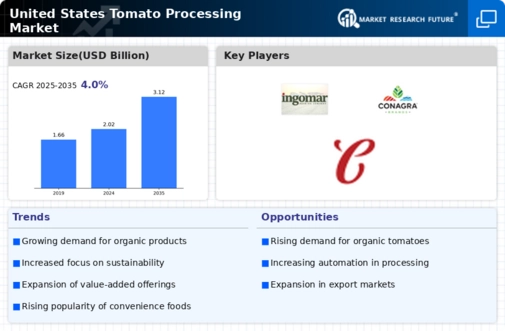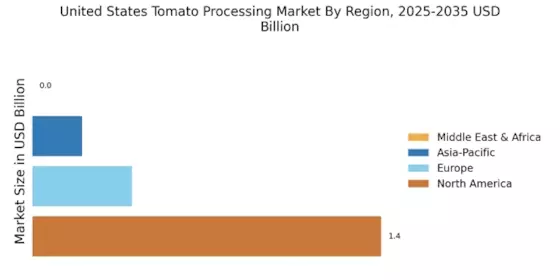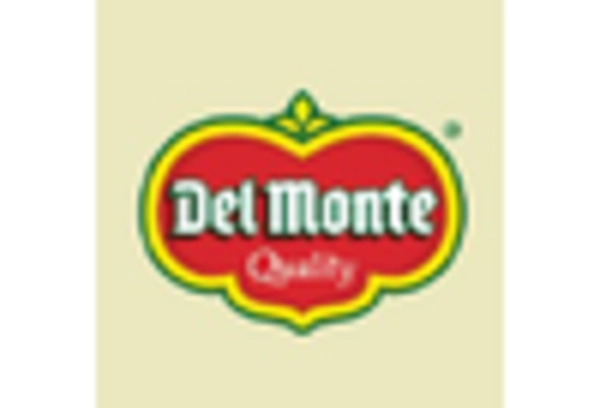Rising Export Opportunities
The United States Tomato Processing Market is poised for growth due to rising export opportunities. With the increasing global demand for processed tomato products, U.S. manufacturers are exploring international markets to expand their reach. In 2023, exports of U.S. tomato products were valued at over 700 million dollars, reflecting a robust interest from foreign markets. This trend indicates that U.S. processed tomatoes are gaining popularity due to their quality and flavor. As trade agreements evolve and international relations improve, it is likely that export volumes will continue to rise, providing a significant boost to the domestic industry. Companies that strategically position themselves in the export market may find substantial growth potential in the coming years.
Expansion of Distribution Channels
The United States Tomato Processing Market is benefiting from the expansion of distribution channels, which is facilitating greater access to processed tomato products. Retailers are increasingly diversifying their offerings, with supermarkets and online platforms providing a wider range of tomato-based products. In 2023, e-commerce sales of food products, including processed tomatoes, accounted for approximately 15% of total food sales, indicating a shift in consumer purchasing behavior. This trend suggests that companies in the tomato processing sector may need to adapt their marketing strategies to leverage these new distribution avenues. As access to products improves, it is likely that overall consumption of processed tomatoes will increase, further driving market growth.
Growing Popularity of Plant-Based Diets
The United States Tomato Processing Market is witnessing a surge in demand for plant-based products, driven by a growing consumer preference for healthier dietary options. As more individuals adopt vegetarian and vegan lifestyles, the demand for tomato-based products such as sauces, pastes, and purees is expected to rise. In 2023, the market for tomato sauces alone was valued at over 1 billion dollars, reflecting a significant increase in consumer interest. This trend indicates that processed tomatoes are becoming essential ingredients in various plant-based dishes, further solidifying their role in the food industry. Consequently, manufacturers are likely to innovate and diversify their product offerings to cater to this expanding market segment.
Technological Advancements in Processing Techniques
The United States Tomato Processing Market is experiencing a notable transformation due to technological advancements in processing techniques. Innovations such as high-pressure processing and improved pasteurization methods enhance product quality while extending shelf life. These advancements not only improve efficiency but also reduce waste, which is crucial in a market where sustainability is increasingly prioritized. The integration of automation and artificial intelligence in processing plants is streamlining operations, leading to cost reductions and increased output. As a result, companies are better positioned to meet the growing demand for processed tomato products, which reached approximately 2.5 million tons in 2023. This trend suggests that the industry is likely to continue evolving, driven by the need for higher quality and more efficient production methods.
Increased Focus on Food Safety and Quality Standards
The United States Tomato Processing Market is increasingly influenced by stringent food safety and quality standards. Regulatory bodies are enforcing more rigorous guidelines to ensure that processed tomato products meet safety requirements, which is crucial for consumer trust. In 2023, the industry saw a rise in compliance costs as companies invested in better quality control measures and certifications. This focus on safety not only protects consumers but also enhances the overall reputation of the industry. As a result, companies that prioritize quality and safety are likely to gain a competitive edge, potentially leading to increased market share in a landscape where consumers are becoming more discerning about their food choices.


















Leave a Comment